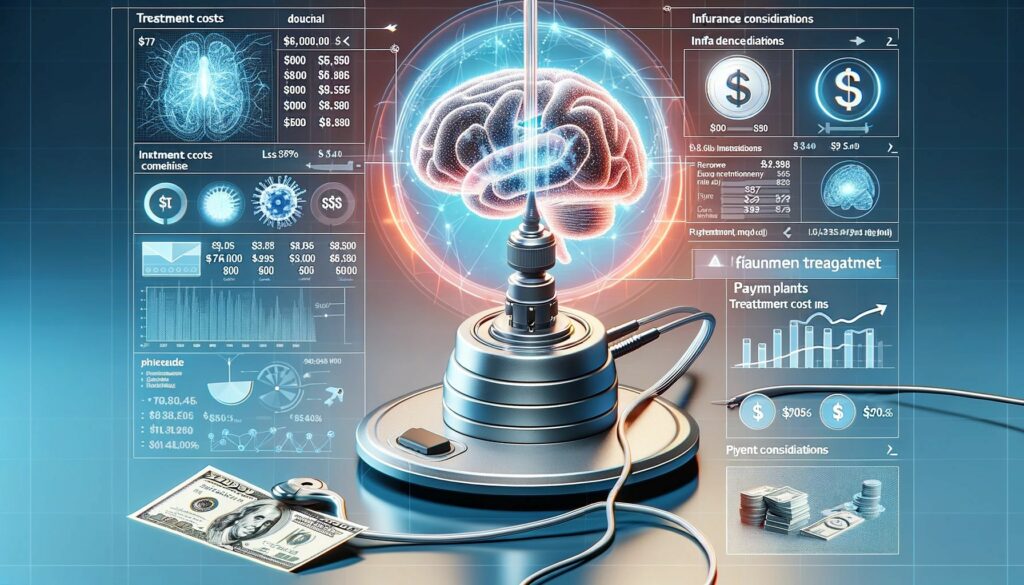When it comes to seeking effective treatment for mental health conditions such as depression and anxiety, there are various options available. One innovative approach that has gained traction in recent years is Transcranial Magnetic Stimulation (TMS) therapy. But what exactly is TMS therapy, and how much does it cost?
In essence, TMS therapy involves the use of magnetic fields to stimulate specific areas of the brain associated with mood regulation. It is a non-invasive procedure that does not require medication or surgery, making it an appealing option for those who have not found relief from traditional treatments.
As for the cost of TMS therapy, it can vary depending on several factors. Factors such as location, duration of treatment, and whether insurance coverage is available can all influence the overall expense. While prices may differ between providers, it’s important to note that TMS therapy typically requires multiple sessions over several weeks to achieve optimal results.
In conclusion, exploring TMS therapy as a potential treatment option for mental health conditions like depression and anxiety raises questions about its affordability. With costs varying based on location and other factors, individuals considering this innovative approach should consult with healthcare professionals and insurance providers to determine if TMS therapy is a viable and financially feasible solution for their needs.
What is TMS Therapy?
TMS therapy, or Transcranial Magnetic Stimulation therapy, is a non-invasive treatment option for individuals experiencing mental health conditions such as depression and anxiety. This innovative therapy involves the use of magnetic fields to stimulate specific areas of the brain that are believed to be associated with these conditions.
Unlike traditional methods like medication or psychotherapy, TMS therapy targets the neural pathways in the brain directly. During a TMS session, an electromagnetic coil is placed on the patient’s scalp near the forehead area. The coil emits magnetic pulses that generate small electrical currents in the brain, stimulating nerve cells and promoting better brain functioning.
One of the key advantages of TMS therapy is its non-systemic nature. Unlike antidepressant medications that can have side effects throughout the body, TMS primarily focuses on improving brain function without causing widespread physiological effects. This makes it particularly appealing for those who may not tolerate or respond well to medication.
Research has shown promising results for TMS therapy in treating various mental health disorders. For example, studies have demonstrated its effectiveness in reducing symptoms of major depressive disorder and improving overall mood and quality of life. It has also been found beneficial for individuals with treatment-resistant depression who have not responded adequately to other forms of treatment.
It’s important to note that while TMS therapy has shown promise, it may not be suitable for everyone. A thorough evaluation by a qualified healthcare professional is necessary to determine if an individual is a good candidate for this type of treatment.
In summary, TMS therapy offers a novel approach to managing mental health conditions by targeting specific areas of the brain through magnetic stimulation. Its non-invasive nature and potential effectiveness make it an attractive alternative for those seeking relief from depression and anxiety symptoms. However, individual assessments are crucial in determining suitability before undergoing this form of therapy.
How Does TMS Therapy Work?
TMS therapy, or Transcranial Magnetic Stimulation therapy, is a non-invasive procedure that uses magnetic fields to stimulate specific regions of the brain. This innovative treatment has shown promise in relieving symptoms of various mental health conditions such as depression, anxiety, and even certain neurological disorders.
The process begins with the patient sitting comfortably in a chair while a trained healthcare professional places an electromagnetic coil against their scalp. The coil emits focused magnetic pulses that penetrate the skull and reach the targeted areas of the brain responsible for regulating mood and emotions.
These magnetic pulses help to activate or inhibit the neural pathways in the brain, promoting changes in brain activity and chemistry. By stimulating these regions involved in mood regulation, TMS therapy aims to restore balance and alleviate symptoms associated with mental health disorders.
Unlike traditional treatments such as medication or electroconvulsive therapy (ECT), TMS therapy does not require sedation or anesthesia. It is generally well-tolerated by patients and carries minimal risk of side effects.
During each session, which typically lasts between 20-40 minutes, patients may experience tapping sensations or mild discomfort on the scalp where the electromagnetic coil is placed. However, these sensations are temporary and subside once the session is complete.
To achieve optimal results, individuals usually undergo multiple sessions over several weeks. The exact number of sessions required can vary depending on factors like individual response to treatment and severity of symptoms. It’s important to note that TMS therapy should always be administered under the guidance of a licensed healthcare professional.
Overall, TMS therapy offers an exciting alternative for individuals seeking relief from mental health conditions without relying solely on medication or more invasive procedures. Its non-invasive nature combined with its potential effectiveness makes it an appealing option for many individuals looking to improve their quality of life.
Conditions Treated with TMS Therapy
Let’s delve into the various conditions that can be effectively treated using Transcranial Magnetic Stimulation (TMS) therapy. This non-invasive procedure has shown promising results in alleviating symptoms of several mental health disorders. Here are a few examples:
- Major Depressive Disorder (MDD): TMS therapy has emerged as a viable alternative for individuals suffering from treatment-resistant depression. Research studies have indicated that it can significantly reduce depressive symptoms and improve overall mood. In fact, the FDA has approved the use of TMS therapy for MDD when other treatments haven’t produced satisfactory results.
- Anxiety Disorders: Beyond depression, TMS therapy has also demonstrated potential in managing anxiety disorders such as generalized anxiety disorder (GAD), panic disorder, and post-traumatic stress disorder (PTSD). By targeting specific areas of the brain associated with anxiety regulation, TMS can help restore balance and provide relief to those struggling with these conditions.
- Obsessive-Compulsive Disorder (OCD): For individuals living with OCD, traditional treatments like medication and psychotherapy may not always yield desired outcomes. However, studies have suggested that incorporating TMS therapy into the treatment plan can offer significant symptom reduction for OCD patients who haven’t responded well to other interventions.
- Bipolar Depression: While bipolar disorder is a complex condition requiring comprehensive management strategies, TMS therapy has shown promise specifically in treating bipolar depression episodes when combined with standard medications and therapies. It may aid in stabilizing moods and reducing depressive symptoms during acute phases.
- Chronic Pain Syndromes: In addition to its application in mental health conditions, TMS therapy is being explored as a potential solution for chronic pain syndromes such as fibromyalgia or neuropathic pain disorders. By modulating neural activity related to pain perception, this innovative approach holds promise for individuals seeking alternatives to conventional pain management techniques.
Remember, the effectiveness of TMS therapy may vary depending on individual circumstances, and it is always essential to consult with a qualified healthcare provider who can assess the suitability of this treatment for your specific condition.
Benefits of TMS Therapy
TMS therapy, or transcranial magnetic stimulation therapy, offers a range of potential benefits for individuals seeking alternative treatment options for mental health conditions. Here are some key advantages to consider:
- Non-Invasive and Drug-Free: One significant benefit of TMS therapy is that it is non-invasive and drug-free. Unlike traditional treatments such as medication or electroconvulsive therapy (ECT), TMS does not require any anesthesia or sedation. This means that patients can avoid potential side effects associated with medications or invasive procedures.
- Targeted Treatment: TMS therapy specifically targets the areas of the brain believed to be involved in mood regulation, making it an effective option for conditions like depression and anxiety disorders. By using magnetic pulses to stimulate these regions, TMS can help restore balance and improve symptoms.
- Minimal Disruption to Daily Life: Another advantage of TMS therapy is its minimal disruption to daily life. Treatment sessions typically last around 20-30 minutes, allowing patients to resume their normal activities immediately after each session. There’s no need for hospital stays or prolonged recovery periods.
- Well-Tolerated with Few Side Effects: Overall, TMS therapy is considered well-tolerated with few side effects compared to other treatment options. The most common side effect reported is mild scalp discomfort or headache during or after a session, which typically resolves quickly.
- Potential Long-Term Benefits: Many individuals who undergo TMS therapy report long-lasting improvements in their mental health symptoms even after completing the recommended course of treatment. This suggests that the benefits of TMS may extend beyond the immediate treatment period.
It’s important to note that while TMS therapy has shown promising results for many individuals, it may not be suitable for everyone or serve as a standalone treatment option. It’s always best to consult with a qualified healthcare professional who can assess your specific needs and determine if TMS therapy is a suitable choice for you.
In the next section, we’ll explore some frequently asked questions about TMS therapy to provide further insights into this innovative treatment approach.
Is TMS Therapy Covered by Insurance?
One of the key concerns individuals may have when considering TMS therapy is whether or not it is covered by insurance. The answer to this question can vary depending on several factors, including the specific insurance provider and the individual’s policy coverage.
While some insurance companies do cover TMS therapy, it’s important to note that not all policies include this treatment as a covered benefit. Before undergoing TMS therapy, it is crucial to reach out to your insurance provider and inquire about their coverage for this particular treatment.
In certain cases, insurance providers may require pre-authorization or documentation from a healthcare professional supporting the medical necessity of TMS therapy. This step helps ensure that the treatment aligns with their criteria for coverage. It’s advisable to work closely with your healthcare provider during this process to gather any necessary documentation and navigate through potential obstacles.
It’s worth mentioning that even if an individual has insurance coverage for TMS therapy, there may still be out-of-pocket costs involved. These costs can include deductibles, co-pays, or coinsurance amounts. Understanding your specific policy terms and financial responsibilities will help you plan accordingly and avoid any unexpected expenses.
In summary, while some insurance companies do cover TMS therapy, it is essential to verify coverage with your specific provider before proceeding with the treatment. Familiarize yourself with any requirements they may have regarding pre-authorization or documentation from a healthcare professional. Additionally, be prepared for potential out-of-pocket costs associated with deductibles, co-pays, or coinsurance amounts.
Remember that each situation is unique; therefore, discussing your options directly with your insurance provider will provide you with accurate information tailored to your circumstances.
Factors Affecting the Cost of TMS Therapy
When it comes to the cost of Transcranial Magnetic Stimulation (TMS) therapy, there are several factors that can influence the overall price. Understanding these factors can help individuals make informed decisions about pursuing this treatment option.
- Location: The location of the TMS therapy provider plays a significant role in determining the cost. Different regions and cities may have varying costs of living, which can result in differences in pricing for TMS therapy. For instance, urban areas with higher overhead costs might charge more compared to rural locations.
- Treatment Duration: The number of sessions required for TMS therapy can impact its cost. Generally, a standard course of treatment consists of multiple sessions spread over several weeks. Each session typically lasts around 30-40 minutes. The total number of sessions recommended will depend on individual needs and response to treatment.
- Insurance Coverage: Insurance coverage for TMS therapy varies from one plan to another and depends on factors such as diagnosis and medical necessity criteria set by insurance providers. Some insurance plans may cover a portion or even the entire cost of TMS therapy, while others may offer partial coverage or none at all. It’s important to check with your insurance provider to understand what is covered under your specific plan.
- Clinic Reputation and Expertise: The reputation and expertise of the clinic or healthcare provider offering TMS therapy can also affect its cost. Established clinics with experienced staff and advanced equipment may charge higher fees due to their track record and quality assurance standards.
- Additional Services: Some clinics may include additional services along with TMS therapy, such as psychiatric evaluations or counseling sessions before or during treatment. These additional services can contribute to the overall cost but may also enhance the effectiveness and outcomes of the treatment process.
It’s worth noting that while these factors play a role in determining the cost of TMS therapy, they should not be the sole criteria for selecting a provider. Quality of care, patient reviews, and personalized treatment plans should also be taken into consideration.
By understanding these factors influencing the cost of TMS therapy, individuals can make more informed decisions about pursuing this innovative treatment option for conditions like depression or anxiety disorders.
Average Cost of TMS Therapy
Let’s dive into the topic of the average cost of Transcranial Magnetic Stimulation (TMS) therapy. TMS is a non-invasive procedure used to treat various mental health conditions, including depression, anxiety, and obsessive-compulsive disorder. As with any medical treatment, it’s important to consider the financial aspect before pursuing this therapy option.
Here are a few key points to keep in mind when discussing the cost of TMS therapy:
- Pricing Factors: The cost of TMS therapy can vary depending on several factors such as location, clinic reputation, and duration of treatment. In general, you can expect to pay between $3000 and $10,000 for a full course of treatment. However, please note that these figures are just rough estimates and may not apply universally.
- Insurance Coverage: While TMS therapy is FDA-approved for treating depression and some other conditions, insurance coverage can vary greatly. Many insurance companies do provide coverage for TMS when it is deemed medically necessary. It’s crucial to check with your insurance provider regarding their specific coverage policies to understand what costs may be covered.
- Out-of-Pocket Expenses: If your insurance does not cover the entire cost or if you don’t have insurance, you will need to consider paying out-of-pocket for TMS therapy sessions. Some clinics offer financing options or sliding scale fees based on income level to make the treatment more affordable.
- Additional Costs: Apart from the actual sessions themselves, there might be additional expenses associated with TMS therapy such as initial consultations or follow-up appointments. It’s essential to inquire about any hidden costs upfront so that you can budget accordingly.
- Research Clinical Trials: For individuals seeking lower-cost alternatives or those who meet certain criteria, participating in clinical trials could be an option worth exploring.
Remember that while cost is a significant consideration when deciding on any medical treatment plan, it’s important not to solely focus on the financial aspect. TMS therapy has shown promising results for many individuals struggling with mental health conditions, and its potential benefits should be carefully evaluated alongside the cost.
In conclusion, when considering TMS therapy, it’s crucial to research different clinics, check insurance coverage, and have a clear understanding of all associated costs. Discussing your options with a healthcare professional can help you make an informed decision about whether TMS therapy is right for you.
Conclusion:
In conclusion, the cost of TMS therapy can vary depending on several factors. Here are a few examples to give you an idea of what to expect:
- Location: The cost of TMS therapy may differ from one location to another. Urban areas with higher living costs tend to have higher treatment prices compared to rural areas.
- Treatment duration: The number of sessions required for TMS therapy can affect the overall cost. Typically, a standard treatment plan consists of 20-30 sessions spread over several weeks.
- Clinic or provider: Different clinics or providers may offer varying pricing structures for TMS therapy. It’s essential to research and compare options in your area to find a reputable provider that fits your budget.
- Insurance coverage: Some health insurance plans offer coverage for TMS therapy, while others may not include it or have limited coverage. Contact your insurance provider directly to inquire about their policy regarding TMS therapy and determine any potential out-of-pocket expenses.
- Additional services: In some cases, additional services such as initial consultations, psychiatric evaluations, or follow-up appointments might be included in the overall cost of TMS therapy.
It’s important to note that these examples are general guidelines and actual costs may vary between providers and regions. To get an accurate estimate, I recommend reaching out directly to local clinics or providers specializing in TMS therapy and discussing your specific needs and circumstances with them.
Remember, when considering the cost of any medical treatment like TMS therapy, it’s crucial to prioritize quality care and professional expertise over price alone.



